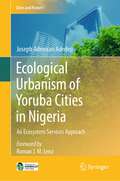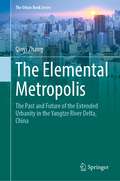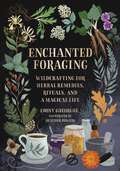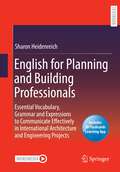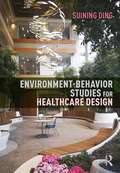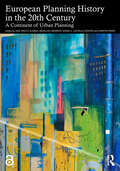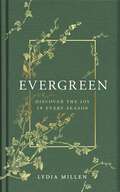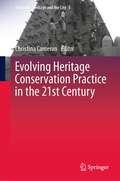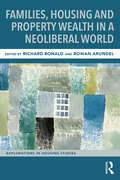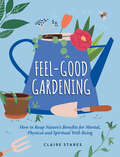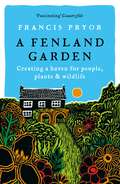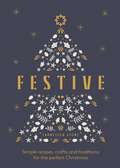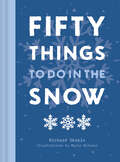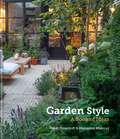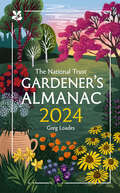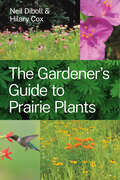- Table View
- List View
Ecological Urbanism of Yoruba Cities in Nigeria: An Ecosystem Services Approach (Cities and Nature)
by Joseph Adeniran AdedejiThis book offers in-depth ethnographic analyses of key informants’ interviews on the ecological urbanism and ecosystem services (ES) of selected green infrastructure (GI) in Yoruba cities of Ile-Ife, Ibadan, Osogbo, Lagos, Abeokuta, Akure, Ondo, among others in Southwest Nigeria. It examines the Indigenous Knowledge System (IKS) demonstrated for wellbeing through home gardens by this largest ethno-linguistic group in Nigeria. This is in addition to the ES of Osun Grove UNESCO World Heritage Site, Osogbo; Biological Garden and Park, Akure; Lekki Conservation Centre, Lagos; Adekunle Fajuyi Park, Ado-Ekiti; Muri Okunola Park, Lagos; and some institutional GI including University of Ibadan Botanical Gardens, Ibadan; Federal University of Agriculture Abeokuta Botanical Garden, Abeokuta; and University of Lagos Lagoon Front Resort, Lagos, Nigeria. The study draws on theoretical praxis of Western biophilic ideologies, spirit ontologies of the Global South, and largely, Millennium Ecosystem Assessment (2005) to examine eco-cultural green spaces, home gardens, and English-types of parks and gardens as archetypes of GI in Yoruba traditional urbanism, colonial and post-colonial city planning. The book provides methods of achieving a form of modernized traditionalism as means of translating the IKS into design strategies for eco-cultural cities. The strategies are framework, model, and ethnographic design algorithms that are syntheses of the lived experiences of the key informants.
The Edible Flower: A Modern Guide to Growing, Cooking and Eating Edible Flowers
by Erin Bunting Jo FacerOn a seven-acre small holding in rural Northern Ireland, organic gardener Jo Facer and head chef Erin Bunting run fork-to-fork supper club, organic small-holding and fledgling cooking and growing school, The Edible Flower. In their first cookbook, learn to grow and cook edible flowers with Jo and Erin's delicious recipes inspired by the seasonal produce they grow in their kitchen garden and the wild food they forage from their local shores and hedgerows. Feast, celebrate and bring people together with over 50 recipes for small plates, mains, desserts, baking, snacks and drinks, at once fresh and flavourful and absolutely stunning to serve. Recipes include: Ribboned Courgette & Avocado Salad with Poppy Seeds & Calendula, Pot Marigold Soda Bread,Lilac Panna Cotta with Strawberries,Rice with Lemon Verbena, Cardamom & Edible Flower Petals,Marigold Petal Pasta,Courgette Flower Tacos,Carnation and Blackberry Cooler,Slow Roast Lamb with Lavender, Lemon & Apricots, Blackberry & Sweet Geranium Tart,Vietnamese Summer Rolls with Violas,Aubergine Katsu Curry with Pickled Magnoliaand many more ...
Edible Houseplants: Grow Your Own Citrus, Coffee, Vanilla, and 43 Other Tasty Tropical Plants
by Laurelynn G. Martin Byron E. MartinThe world of houseplants just got tastier with this colorful guide to growing edible plants indoors! Houseplant enthusiasts will be delighted to discover the range of tropical plants that can be grown in containers indoors, in any location. Laurelynn and Byron Martin, owners of Logee's Plants for Home & Garden, are nationally renowned for their expertise in growing fruit-bearing and tropical plants indoors. Their colorful guide features photos and complete care guidelines for 46 food-bearing plants, includes lemons, limes, grapefruit, cherries, olives, passion fruit, papaya, and much more. Fresh, fragrant, and flavorful, Edible Houseplants expands the fun and pleasure of growing indoor plants.
The Elemental Metropolis: The Past and Future of the Extended Urbanity in the Yangtze River Delta, China (The Urban Book Series)
by Qinyi ZhangThis book provides a multi-scale reading of the spatial “elements” in which the extensive urbanity in Yangtze River Delta is constructed, and from there an imagination of a new paradigm of urbanization. The urbanization in Yangtze River Delta today is in need of a new interpretation and paradigm. The delta is a territory with city cores but it also has vast dispersed urbanization where the agricultural and non-agricultural activities and spaces are mixed and interlinked, a desakota (McGee, 1991). This book attempts to answer a basic question: what is the desakota in the Yangtze River Delta made of? The research Horizontal Metropolis led by Prof. Paola Viganò at EPFL, Switzerland focuses on the form of the contemporary city – the fragmentary spatial condition and dispersed urbanity all over the world. The study on Yangtze River delta is part of its research frame.
Enchanted Foraging: Wildcrafting for Herbal Remedies, Rituals, and a Magical Life
by Ebony GheorgheEmbark on your foraging journey and cultivate a more meaningful, magical relationship with nature. No matter where you live, natural resources are all around you. These pieces of nature hold inherent properties—and inherent magic—that could be useful to you, and they are often hiding in plain sight. In this book, divided into chapters by season, you'll find: Tips for foraging correctly, mindfully, and sustainably Instructions for teas, balms, decoctions, and other herbal remedies made out of foraged ingredients and materials Wildcrafts for rituals that usher in the new season, inspired by mystical folk practices around the world And more! With practical advice for novice foragers and sidebars on how different cultures have connected with the greatest mystic of all, Mother Earth, Enchanted Foraging explores plants and their various uses not just for consumption but for their intrinsic value. Readers will come away with a more complete knowledge of, and appreciation for, the world that lies just beyond their doors--its abundance, hidden applications, and how it makes enchanted beings of us all.
The Encyclopedia of Cut Flowers: What Flowers to Buy, When to Buy Them, and How to Keep Them Alive Longer
by Calvert CraryFrom Calvert Crary and Bruce Littlefield, The Encyclopedia of Cut Flowers is a comprehensive, gorgeously visual guide that answers every question you've ever had (and a few you didn't know to ask!) about buying, caring for, and prolonging the lives of more than 140 different varieties of commonly available cut flowers.The Encyclopedia of Cut Flowers dives deep into the world of fresh-cut flowers, featuring unique entries for 143 different varieties of commonly available cut flowers that readers can buy at their local grocery store or flower market. Each flower entry offers authoritative tips for conditioning methods (eg–cut flowers should never be put near fresh fruit because fruit produces ethylene gas which will shorten the flowers' life), as well as scientific and common names, best seasons for buying (eg—lilies in spring, dahlias in summer) and fascinating facts about each bloom. An introductory section offers basic tips for styling arrangements at home, and for keeping flowers hydrated and alive for as long as possible. By the time readers are done flipping through the pages of The Encyclopedia of Cut Flowers, which features more than 150 gorgeous color photographs of flowers, they'll be experts in the field!
English for Planning and Building Professionals: Essential Vocabulary, Grammar and Expressions to Communicate Effectively in International Architecture and Engineering Projects
by Sharon HeidenreichThis language course book provides the tools to communicate effectively throughout the development of construction projects. It includes the most important vocabulary, grammar and expressions for the successful collaboration in English-speaking planning teams.The 16 chapters are organised according to the planning phases of a project, introducing essential vocabulary from the brief and feasibility study through to the completion and acceptance of a scheme. The planning and development of a single-family home provides a framework to practise business skills, such as telephoning, writing emails and negotiating. Important grammar structures have been included to offer readers the opportunity to refresh and practise elements appropriate to the phase of construction.In addition to the book contents, readers have access not only to audios by scanning the QR codes at the conversations but also the Springer Nature Flashcards-App, which can be downloaded free of charge, to learn vocabulary more effectively with 320 digital flashcards.According to the Common European Framework of Reference for Languages, the level of this book is B2/C1.
Environment-Behavior Studies for Healthcare Design
by Suining DingEnvironment-Behavior Studies for Healthcare Design explains how environment-behavior (EB) studies can contribute to healthcare design research and explores how evidence-based theories can be applied and integrated into the healthcare design practice. Drawing on EB theories and the latest research in environment-behavior studies, this book shows how the healthcare environment can positively impact patients' and caregivers' well-being and healthcare organization's efficiency by modifying environmental attributes, such as space configuration, color, lighting, signage, acoustics, and artwork. It addresses a range of healthcare facilities including children's hospitals, long-term care, acute care and outpatient care facilities, and uses a range of evidence-based design research methods, such as interviews, focus groups, observations, surveys and space syntax. The author also explains how research evidence and evidence-based design can be integrated into healthcare design more cohesively in a redefined design process. This book provides a solid conceptual structure that informs a clear map for understanding the EB theories and their applications in healthcare design. This research guide for healthcare design helps students, academics, designers and architects reconsider how to create environments that support patients’ healing and well-being whilst considering efficiency and safety.
Environment-Behavior Studies for Healthcare Design
by Suining DingEnvironment-Behavior Studies for Healthcare Design explains how environment-behavior (EB) studies can contribute to healthcare design research and explores how evidence-based theories can be applied and integrated into the healthcare design practice. Drawing on EB theories and the latest research in environment-behavior studies, this book shows how the healthcare environment can positively impact patients' and caregivers' well-being and healthcare organization's efficiency by modifying environmental attributes, such as space configuration, color, lighting, signage, acoustics, and artwork. It addresses a range of healthcare facilities including children's hospitals, long-term care, acute care and outpatient care facilities, and uses a range of evidence-based design research methods, such as interviews, focus groups, observations, surveys and space syntax. The author also explains how research evidence and evidence-based design can be integrated into healthcare design more cohesively in a redefined design process. This book provides a solid conceptual structure that informs a clear map for understanding the EB theories and their applications in healthcare design. This research guide for healthcare design helps students, academics, designers and architects reconsider how to create environments that support patients’ healing and well-being whilst considering efficiency and safety.
European Planning History in the 20th Century: A Continent of Urban Planning
by Max Welch Guerra Abdellah Abarkan María A. Castrillo Romón Martin PekárThe history of Europe in the 20th century is closely tied to the history of urban planning. Social and economic progress but also the brute treatment of people and nature throughout Europe were possible due to the use of urban planning and the other levels of spatial planning. Thereby, planning has constituted itself in Europe as an international subject. Since its emergence, through intense exchange but also competition, despite country differences, planning has developed as a European field of practice and scientific discipline. Planning is here much more than the addition of individual histories; however, historiography has treated this history very selective regarding geography and content. This book searches for an understanding of the historiography of planning in a European dimension. Scholars from Eastern and Western, Southern and Northern Europe address the issues of the public led production of city and the social functions of urban planning in capitalist and state-socialist countries. The examined examples include Poland and USSR, Czech Republic and Slovakia, UK, Netherlands, Germany, France, Portugal and Spain, Italy, and Sweden. The book will be of interest to students and scholars for Urbanism, Urban/Town Planning, Spatial Planning, Spatial Politics, Urban Development, Urban Policies, Planning History and European History of the 20th Century.
European Planning History in the 20th Century: A Continent of Urban Planning
by Max Welch Guerra Abdellah Abarkan Castrillo Romón, María A. Martin Pekár Victoria GrauThe history of Europe in the 20th century is closely tied to the history of urban planning. Social and economic progress but also the brute treatment of people and nature throughout Europe were possible due to the use of urban planning and the other levels of spatial planning. Thereby, planning has constituted itself in Europe as an international subject. Since its emergence, through intense exchange but also competition, despite country differences, planning has developed as a European field of practice and scientific discipline. Planning is here much more than the addition of individual histories; however, historiography has treated this history very selective regarding geography and content. This book searches for an understanding of the historiography of planning in a European dimension. Scholars from Eastern and Western, Southern and Northern Europe address the issues of the public led production of city and the social functions of urban planning in capitalist and state-socialist countries. The examined examples include Poland and USSR, Czech Republic and Slovakia, UK, Netherlands, Germany, France, Portugal and Spain, Italy, and Sweden. The book will be of interest to students and scholars for Urbanism, Urban/Town Planning, Spatial Planning, Spatial Politics, Urban Development, Urban Policies, Planning History and European History of the 20th Century.
Evergreen: Discover the Joy in Every Season
by Lydia Elise MillenInspired by the wisdom of the natural world, Evergreen is the essential guide for anyone who is looking to unearth their inner strength and bring more joy and contentment into their everyday. Season by season, Evergreen guides you to reconnect with nature and find balance throughout the inevitable ebb and flow of life. From learning to trust your intuition to embracing the power of amateur status, rethinking your relationship with comparison to seeking solitude when you need it, Lydia Millen takes you by the hand and empowers you with the tools to create your own version of an evergreen life.Whether Evergreen finds you at a time of peace and fulfilment or a time of challenge and uncertainty, this book will uplift you with a fresh perspective and be a comfort you can return to in every season of your journey to come.
Evolving Heritage Conservation Practice in the 21st Century (Creativity, Heritage and the City #5)
by Christina CameronThis book focuses on current trends in cultural heritage conservation and their influence on heritage practice. Seen through the lenses of World Heritage, historic urban landscapes, heritage tourism, climate change or the nature/culture nexus, these challenges call for innovative approaches to protect and conserve our heritage places. The book brings together the voices of different stakeholders in the heritage conservation process, ranging from scholars, site managers and government officials to young professionals and students.
Families, Housing and Property Wealth in a Neoliberal World (Explorations in Housing Studies)
by Richard Ronald Rowan ArundelThe twenty-first century has so far been characterized by ongoing realignments in the organization of the economy around housing and real estate. Markets have boomed and bust and boomed again with residential property increasingly a focus of wealth accumulation practices. While analyses have largely focussed on global flows of capital and large institutions, families have served as critical actors. Housing properties are family goods that shape how members interact, organise themselves, and deal with the vicissitudes of everyday economic life. Families have, moreover, increasingly mobilized around their homes as assets, aligning household transitions and practices towards the accumulation of property wealth. The capacities of different families to realise this, however, are highly uneven with housing conditions becoming increasingly central to growing inequalities and processes of social stratification. This book addresses changing relationships between families and their homes over the latest period of neo-liberalization. The book confronts how transformations in households, life-course transitions, kinship and intergenerational relations shape, and are being shaped by, the shifting role of property markets in social and economic processes. The chapters explore this in terms of different aspects of home, family life and socioeconomic change across varied national contexts.
Families, Housing and Property Wealth in a Neoliberal World (Explorations in Housing Studies)
by Richard Ronald Rowan ArundelThe twenty-first century has so far been characterized by ongoing realignments in the organization of the economy around housing and real estate. Markets have boomed and bust and boomed again with residential property increasingly a focus of wealth accumulation practices. While analyses have largely focussed on global flows of capital and large institutions, families have served as critical actors. Housing properties are family goods that shape how members interact, organise themselves, and deal with the vicissitudes of everyday economic life. Families have, moreover, increasingly mobilized around their homes as assets, aligning household transitions and practices towards the accumulation of property wealth. The capacities of different families to realise this, however, are highly uneven with housing conditions becoming increasingly central to growing inequalities and processes of social stratification. This book addresses changing relationships between families and their homes over the latest period of neo-liberalization. The book confronts how transformations in households, life-course transitions, kinship and intergenerational relations shape, and are being shaped by, the shifting role of property markets in social and economic processes. The chapters explore this in terms of different aspects of home, family life and socioeconomic change across varied national contexts.
Feel-Good Gardening: How to Reap Nature's Benefits for Mental, Physical and Spiritual Well-Being
by Claire StaresWhether you're hoping to cultivate a calmer mindset, nurture your physical strength or connect with your community, the restorative powers of gardening can help you flourish. With valuable information, actionable tips and creative ideas, this book will help you discover the all-round health benefits that can come while honing your green fingers.
A Fenland Garden: Creating a haven for people, plants & wildlife
by Francis PryorThe story of how Francis Pryor created a haven for people, plants and wildlife in a remote corner of the fens.A Fenland Garden is the story of the creation of a garden in a complex and fragile English landscape – the Fens of southern Lincolnshire – by a writer who has a very particular relationship with landscape and the soil, thanks to his distinguished career as an archaeologist and discoverer of some of England's earliest field systems. It describes the imagining, planning and building of a garden in an unfamiliar and sometimes hostile place, and the challenges, setbacks and joys these processes entail. This is a narrative of the making of a garden, but it is also about reclaiming a patch of ground for nature and wildlife – of repairing the damage done to a small slice of Fenland landscape by decades of intensive farming.A Fenland Garden is informed by the empirical wisdom of a practising gardener (and archaeologist) and by his deep understanding of the soil, landscape and weather of the region; Francis's account of the development of the garden is counterpointed by fascinating nuggets of Fenland lore and history, as well as by vignettes of the plantsman's trials and tribulations as he works an exceptionally demanding plot of land. Above all, this is the story of bringing something beautiful into being; of embedding a garden in the local landscape; and thereby of deepening and broadening the idea of home.
Festive: Simple recipes, crafts and traditions for the perfect Christmas
by Francesca StoneMake Christmas magicIn this book, you'll find easy, accessible ways to embrace your festive spirit and create lasting memories with the family with a collection of traditions - old and new - including simple recipes, styling tips and crafts to make your celebrations meaningful and beautiful without the big spend.By using traditional, low-cost ingredients to create simple and tasty festive recipes and foraging, recycling, and using inexpensive items from around your home for cosy styling and beautiful crafts to keep or give as gifts, you can have a perfect, budget-friendly and more sustainable Christmas.Recipes will include Mini gingerbread house biscuits, Brie and cranberry waffles, Christmas Cake and Mince pies, with styling tips covering how to dress your front door, tree and shelves, and crafts ranging from honeycomb paper trees to creating needle felted ornaments, recycled wax candles and natural beaded garlands.This is a book you'll reach for year on year.
Fifty Things to Do in the Snow
by Richard SkreinIcy inspiration for playing, exploring and surviving in the snow. Don’t be put off by the cold – get out there and be dazzled by the wonder of winter. With fifty projects for having fun and staying safe in the snow, you’ll never be short of ideas.
Firescaping Your Home: A Manual for Readiness in Wildfire Country
by Adrienne Edwards Rachel SchleigerThis hardworking, actionable guide is a must-have for homeowners looking to fight the risks of wildfire spreading to their homes and property. Wildfires are burning over longer seasons and more intensely than ever before, and everyone living in a wildland-urban interface or wildland-adjacent area should take precautionary steps to mitigate the risk of property damage. In Firescaping Your Home, Adrienne Edwards and Rachel Schleiger provide expert guidance and specific recommendations on how to harden your home against fire and create defensible space that is lush and attractive. They also provide in-depth native plant lists of hundreds of species that have evolved to coexist with fire in the West, and show how and why including these on your property sustains wildlife and can actually be your most powerful defense.
The Garden Maker's Book of Wonder: 162 Recipes, Crafts, Tips, Techniques, and Plants to Inspire You in Every Season
by Allison Vallin KostovickThe joy and wonder of a garden-inspired lifestyle is captured in this colorfully photographed, through-the-seasons sourcebook filled with recipes, gardening wisdom, craft and wellness projects, and nature-based activities. Each season in the garden brings new joy and fresh inspiration for connecting with the wonders of the natural world. In The Garden Maker's Book of Wonder, popular gardening lifestyle influencer Allison Vallin Kostovick (Finch + Folly) invites fans of cottagecore, gardening, and nature-based living to share her journey as she crafts, cooks, dreams, and creates. Drawing on decades of gardening experience, and illustrated with vibrant photography from her own home and garden, The Garden Maker's Book of Wonder offers sage advice on growing bountiful harvests of favorite vegetables, herbs, and flowers. All levels of gardeners, from dreamers to the experienced, will delight in the variety and creativity of Kostovick's projects, activities, and recipes for enjoying the magic and whimsy of the natural world—no matter what season. From planting a pollinator playground to building a rustic trellis from tree branches, cooking with freshly picked peas and mint to making a sweet viola tub soak, and growing a bird seed mix to crafting one-of-a-kind jewelry beads from the husks of the Job's Tears plant, the inventive ideas in this rich treasury are sure to make it a favorite to keep and to give to anyone who aspires to a more nature-connected lifestyle. This publication conforms to the EPUB Accessibility specification at WCAG 2.0 Level AA.
Garden Style: A Book of Ideas
by Heidi Howcroft Marianne MajerusGardens have never been as important as they are today. The breadth of styles and types is hugely varied. Everything goes, whether inspired by the past or looking towards the future, from traditional vegetable plots to vertical gardens and from nature-filled designs to sleek, modernist creations. Choosing what suits your space can be a daunting prospect and everyone, even the professionals, needs help to realize opportunities and create outdoor spaces in tune with their personal needs and dreams. A garden is what we make it: there is no right or wrong way and each is unique.Richly illustrated by the photos of award-winning photographer Marianne Majerus and with illuminating text by landscape architect Heidi Howcroft, this book shows what is possible for every type of garden, from challenging small spaces to expansive plots. Design tools are explained, planting styles explored, and inspiration is drawn from a wide variety of locations and climates to appeal to garden owners and designers everywhere.The book is not only a companion to Garden Design: A Book of Ideas but is also a valuable style catalogue and sourcebook in its own right, encouraging and inspiring readers to discover their own garden style - be it contemporary or traditional, cottage-style or urban minimalist.
The Gardener’s Almanac 2024 (National Trust)
by Greg Loades National Trust BooksInformation, inspiration, tips and trivia to help you make the most of your gardening year
The Gardener's Guide to Prairie Plants
by Neil Diboll Hilary CoxA comprehensive and beautifully illustrated reference for all gardeners passionate about native plants and prairie restoration. The Gardener’s Guide to Prairie Plants is the one-stop compendium for all gardeners aspiring to use native prairie plants in their gardens. Neil Diboll and Hilary Cox—two renowned prairie gardeners—compile more than four decades’ worth of research to offer a wide-ranging and definitive reference for starting and maintaining prairie and meadow gardens and restorations. Alongside detailed synopses of plant life cycles, meticulous range maps, and sweeping overviews of natural history, Diboll and Cox also include photographs of 148 prairie plants in every stage of development, from seedling to seedhead. North America’s grasslands once stretched from the Blue Ridge to the Rocky Mountains, and from Texas to Manitoba, blanketing the mid-continent with ecologically important, garden-worthy, native species. This book provides all the inspiration and information necessary for eager native planters from across the country to welcome these plants back to their landscapes. The Gardener’s Guide to Prairie Plants is a must-have reference for gardeners, restorationists, and every flora fan with a passion for native plants, prairies and meadows.
The Gardener's Guide to Prairie Plants (Emersion: Emergent Village Resources For Communities Of Faith Ser.)
by Neil Diboll Hilary CoxA comprehensive and beautifully illustrated reference for all gardeners passionate about native plants and prairie restoration. The Gardener’s Guide to Prairie Plants is the one-stop compendium for all gardeners aspiring to use native prairie plants in their gardens. Neil Diboll and Hilary Cox—two renowned prairie gardeners—compile more than four decades’ worth of research to offer a wide-ranging and definitive reference for starting and maintaining prairie and meadow gardens and restorations. Alongside detailed synopses of plant life cycles, meticulous range maps, and sweeping overviews of natural history, Diboll and Cox also include photographs of 148 prairie plants in every stage of development, from seedling to seedhead. North America’s grasslands once stretched from the Blue Ridge to the Rocky Mountains, and from Texas to Manitoba, blanketing the mid-continent with ecologically important, garden-worthy, native species. This book provides all the inspiration and information necessary for eager native planters from across the country to welcome these plants back to their landscapes. The Gardener’s Guide to Prairie Plants is a must-have reference for gardeners, restorationists, and every flora fan with a passion for native plants, prairies and meadows.
